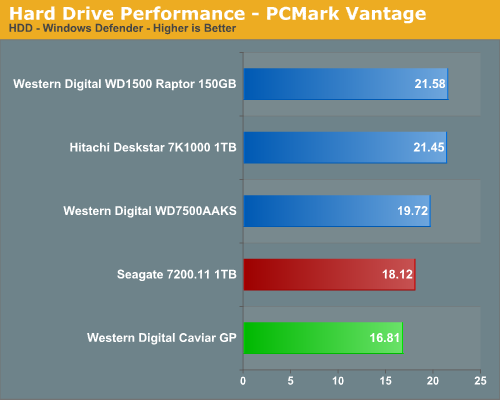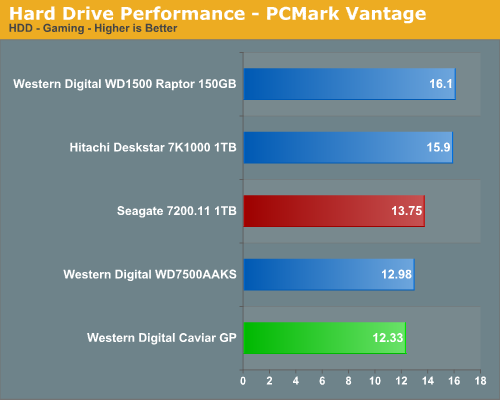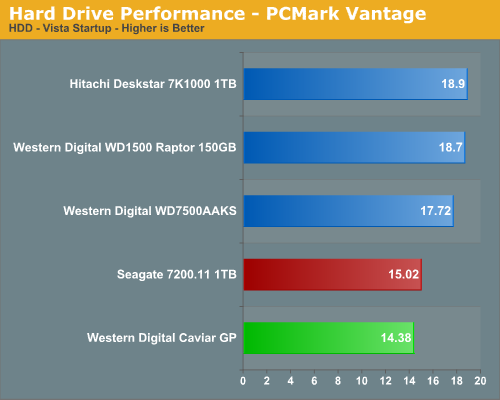Seagate and Western Digital 1TB Drives: Improved and Green
by Dave Robinet on November 26, 2007 7:00 AM EST- Posted in
- Storage
Windows Vista
Vista (and its associated drivers and applications) has finally matured to the point where we feel comfortable including it in our benchmark suite. To that end, we are pleased to include the following as our inaugural Vista storage selections:
- Windows Vista Startup / Shutdown
- PCMark Vantage
Going forward, we will continue to expand the Vista benchmark and application selection as they become ready for prime time. With this in mind, we have chosen not to include hibernation benchmarks in our initial round of testing due to related issues with Vista. Service Pack 1 should go a long way towards resolving these issues (and initial looks at the latest release candidate suggest that it does), so we will revisit this decision when the final release of SP1 comes out.
Our Vista strategy follows the one we are using for Windows XP. We apply only major milestone releases (SP1, SP2, etc) and keep drivers updated as necessary. Whenever there is a major driver (or OS) update, we will go back and re-run previous benchmarks to ensure that the data set remains consistent. For our tests, we disable Windows Defender, set the paging file to a static 3.0GB in size, and limit the Recycle Bin to 1GB maximum. We also close the Sidebar application.
PCMark Vantage
PCMark Vantage is the latest benchmark available from Futuremark, and is available only on Windows Vista. Similar to the venerable PCMark05 in its makeup, Vantage modernizes the criteria and test methodology to reflect what users may encounter when running the new Windows OS.
For the HD test suite, the white paper breaks the tests down as:
- Windows Defender: Windows Defender performs a scan operation, resulting in a read-intensive (99.5% read, 0.5% write) benchmark reflecting a common task in Windows Vista.
- Gaming Performance: Streaming performance is measured using actual game mechanics found in Alan Wake. This test is nearly all read (99.95% read, 0.05% write) in nature.
- Windows Photo Gallery: A large collection of images is imported into Windows Photo Gallery. This is the first of the tests which bring write performance into account in a meaningful way, with a roughly 84% read, 16% write ratio.
- Windows Vista Startup: Simulates Windows Vista start-up operations, producing a test that breaks down to roughly 85% read and 15% write operations.
- Windows Movie Maker: The first of the Vantage tests which comes close to equally dividing read and write operations (54% read, 46% write), concurrent video performance is tested both for video read and skip performance, as well as video write operations.
- Windows
Media Center: Performing three distinct tasks:
- SDTV video playback
- SDTV video streaming to Extender for Windows Media Center
- SDTV video recording
- Windows Media Player: Adds music to Windows Media Player. This test reverts to favoring read operations (78% read, 22% write).
- Application
Loading: The following applications are loaded:
- Microsoft Word 2007
- Adobe Photoshop CS2
- Internet Explorer 7
- Outlook 2007
The total benchmark is roughly 87% reads and 13% writes in nature. We run each test five times per drive, producing a median score that we use for comparison in our charts.















31 Comments
View All Comments
darshahlu - Monday, November 26, 2007 - link
One thing I would have liked to see in the article is a RAID test. Specifically, I wonder whether or not the WD drive with its variable rotational speed will have problems in RAID configurations.In my experience with the WD drives, the answer to this question is yes. I have two of the WD Terabyte drives in a RAID MIRROR setup. The issue I noticed is that while copying data onto the mirror from multiple sources, some data becomes corrupt. I contacted WD support about the problem and am waiting to hear back from them. Perhaps it is true that these WD drives simply do not work well in a RAID setup.
Has anyone else experienced problems with the WD drives in RAID?
Darshan
darshahlu - Thursday, December 6, 2007 - link
I contacted WD about RAID support. Here is the response:Response (Jeremy H.) 12/06/2007 05:59 PM
Dear Darshan,
Thank you for contacting Western Digital Customer Service and Support.
The WD10EACS is a desktop drive. WD desktop drives do not work properly when used in a RAID array. I recommend you exchange your WD10EACS drives for the RAID model, WD1000FYPS.
Answer Title: What is the difference between Desktop edition and RAID (Enterprise) edition hard drives?
Answer Link: http://wdc.custhelp.com/cgi-bin/wdc.cfg/php/enduse...">http://wdc.custhelp.com/cgi-bin/wdc.cfg...?p_faqid...
Answer Title: Specifications for the Western Digital RAID edition Serial ATA hard drives.
Answer Link: http://wdc.custhelp.com/cgi-bin/wdc.cfg/php/enduse...">http://wdc.custhelp.com/cgi-bin/wdc.cfg...?p_faqid...
Sincerely,
Jeremy H.
Western Digital Service and Support
http://support.wdc.com">http://support.wdc.com
Zak - Monday, November 26, 2007 - link
I was hoping they'd introduce ACS (Actual Capacity Specification) with the 1TB drives so when I look in My Computer it would actually say 1 TB under Total Size instead of 930 GB. Uncool :rolleyes:Z.
JarredWalton - Monday, November 26, 2007 - link
SI has settled on TB for 1 trillion for a long time. If you want 2^40 bytes, you'll need TiB (tebibyte). While computers have been using Kilo, Mega, Giga, Tera for a long time, the fact is that those were originally designated as 1000, 1000000, 1 billion, 1 trillion, etc. before computers began using the abbreviations. Computer scientists were lazy (as usual - I can say that because I studied CS) and simply used Kilo for 1024 because it was "close enough".As far as I'm concerned, "ACS" has been in use for a long time; now we just need to get operating systems and users to understand the correct meaning of SI prefixes. :)
Chadder007 - Monday, November 26, 2007 - link
What...no check on wattage usage on the drives? If its a "green" drive id like to know how much power its actually saving.nowayout99 - Monday, November 26, 2007 - link
Ditto. I was expecting to see some sort of power draw comparison, afterall the one drive is marketed as being "green."Instead, we're asked to take their word for it.
drebo - Monday, November 26, 2007 - link
Why is it that almost every single article Anandtech puts out has a conclusion that contradicts their own test results?Seriously. If the two drives are so different and so suited for different purposes, why are you even comparing them? If it's just to say that the WD drive excells at being green and the Seagate drive sucks at performance, why even bother with an article?
You cannot judge the drives solely on the merits of the competition while ignoring what the drive is good at.
This right here: "the redeeming feature of the Seagate drive is only that it turns in better results than the Western Digital drive". That's a no-brainer, and anyone could have guessed that by looking at the manufacturer specs. More to the point: wasn't that the goal of the article--to find out which of the two performed better? So, why, in your conclusion, do you completely ignore the fact that the Seagate drive is clearly the better performer?
You judge the Seagate drive for not being quiet, for running hot, for having bad performance, yet you completely ignore the fact that in your little "head-to-head" comparison, it is the victor in terms of performance. By that same token, you praise the Western Digital drive for being quient, for running cool, and you completely ignore the fact that it performed worse than any other drive tested.
The bias on this site is palpable. So much for honest reviews.
yuchai - Monday, November 26, 2007 - link
Do you actually make a HD purchase decision solely based on performance?I actually liked the conclusion. Sure, the WD is slower in almost everything. But if you look at the real life benchmarks it's only about 5% in all apps except WinRAR. Is this difference high enough to offset the savings in price and power consumption? I think this is the type of question that the consumer should be asking, and the conclusion does a good job at doing just that.
Anyway, if you do not like the conclusion, you can easily look at the facts and benchmarks only and make your own call. Ultimately, AT can only give information and recommendations. The decision maker is still you.
JEDIYoda - Monday, November 26, 2007 - link
Exactly what gamer in their right mind is going to be using that 1T for gaming anyways??Things that make you go hmmm....
JarredWalton - Monday, November 26, 2007 - link
This isn't just a comparison of Seagate to Western Digital, obviously. That's why there are several other hard drives listed in the benchmarks. The conclusion for the Seagate fits with the benchmarks: it is slower than (or at best equal to) the Hitachi 1TB drive in every single test. The only thing it has going for it is a five-year warranty, which doesn't count for much in my book. Sure, you can get a replacement drive for an extra two years, but until manufacturers start providing data recovery as part of the warranty I just don't think it's a big deal. I have dozens of hard drives from all the major manufacturers; granted, I'm not stressing every single drive 24/7, but drive failures are uncommon - whether in the first three years or at 4-5 years.WD has lower power (meh - 4W is *nothing* when it comes to power!), but it also has a much lower price. Seagate has a price that is $5 cheaper than Hitachi (at Newegg - though I admit I'm not sure what the difference is between the four Hitachi 1TB drives that show up). The "enterprise" version is also $25 more than most expensive Hitachi - $55 more than the cheapest 1TB Hitachi. Given the better performance (Seagate has low write performance) and essentially equal price, we'd recommend the Hitachi over the Seagate.